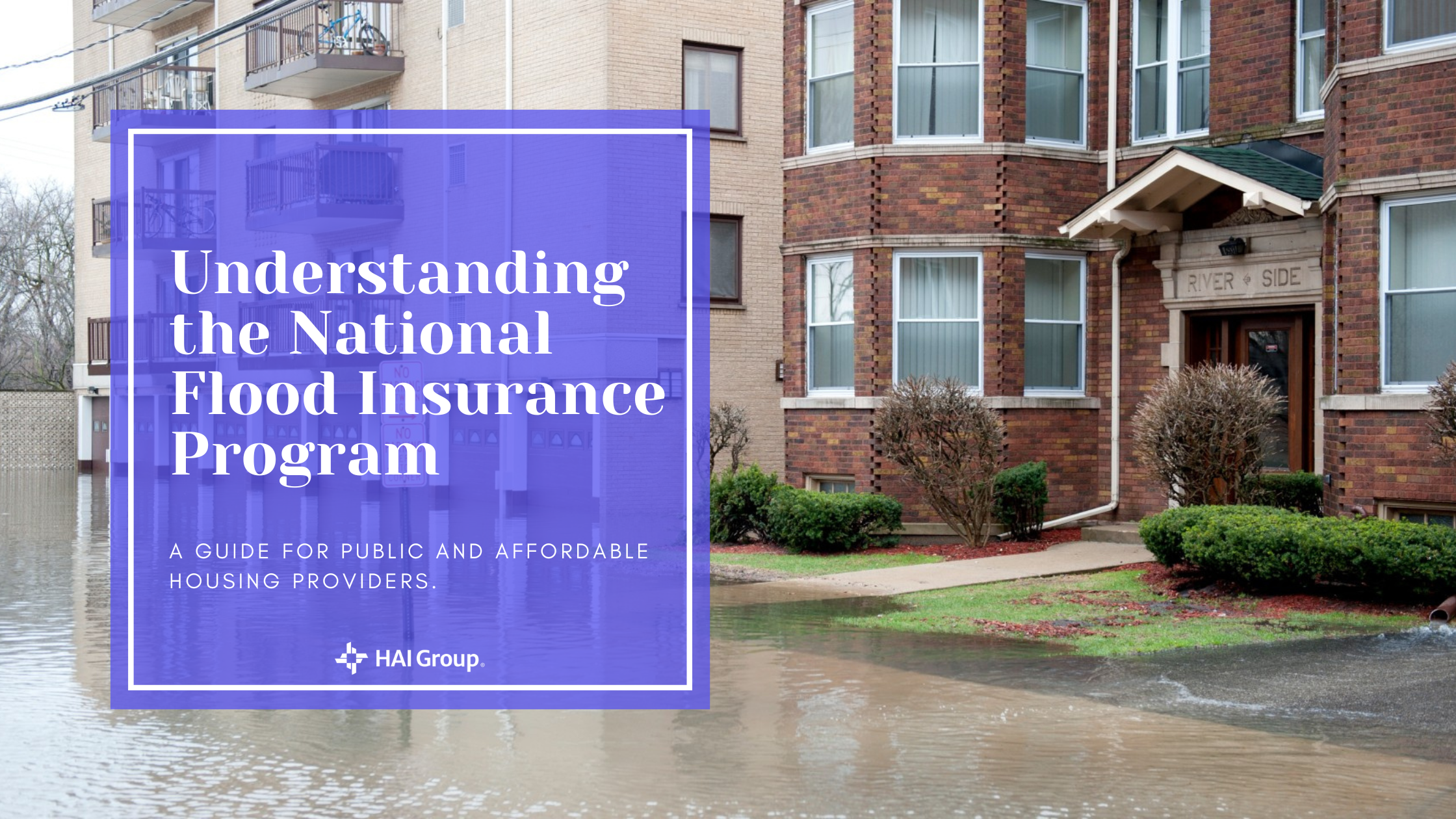Understanding the National Flood Insurance Program: A Guide for Public and Affordable Housing Providers

Flooding is one of the most common and costly natural disasters in the United States, posing significant property risks, especially in public and affordable housing. The National Flood Insurance Program (NFIP), managed by the Federal Emergency Management Agency (FEMA), is a vital resource for housing providers to protect their assets and ensure the safety and security of their residents.
This guide explains the NFIP's essentials, highlights the importance of securing flood insurance coverage, and explains why it's prudent to consider a flood policy—even for properties not located in designated flood zones.
Why was the National Flood Insurance Program (NFIP) established?
Congress established the NFIP in 1968 in response to the growing realization that floods were not only devastating for communities but also financially crippling. Private insurers increasingly refused to cover flood damage due to the high risk and potential for enormous payouts. This left many property owners, particularly those in flood-prone areas, without financial recourse after a flood.
Recognizing the need for a federal solution, Congress established the NFIP to provide affordable flood insurance to property owners while encouraging communities to adopt and enforce floodplain management regulations. The program's dual purpose was to reduce the financial impact of flooding on properties and promote better land use and building practices to mitigate future flood risks.
The role of the NFIP today
Today, the NFIP remains the primary source of flood insurance for property owners across the country. Flood coverage is typically excluded from standard property insurance policies, making the NFIP an essential tool for managing flood risk. The program offers federally-backed flood insurance to property owners, renters, and businesses, ensuring that communities, especially those in flood-prone areas, can access necessary coverage.
 Flooding in New Orleans after Hurricane Katrina | Getty Images
Flooding in New Orleans after Hurricane Katrina | Getty Images
Significant natural disasters, such as Hurricane Katrina in 2005, have underscored the importance of the NFIP. Katrina's widespread devastation highlighted the immense financial and human toll of flooding, particularly in vulnerable communities. The NFIP played a crucial role in the recovery process, providing billions of dollars in claims to help rebuild homes, businesses, and infrastructure. The disaster also emphasized the program's critical role in ensuring that property owners, especially those in public and affordable housing, have the financial protection they need when floods occur.
HAI Group does not directly participate in the NFIP program or offer flood insurance but can access it through a network of carrier partners. HAI Group account executives, who are also licensed insurance agents, can procure a variety of coverages beyond HAI Group's product portfolio. If you're an HAI Group policyholder in need of flood coverage, contact your account executive for assistance.
How public and affordable housing providers can ensure coverage
1. Understanding flood zones
 An example of FEMA's flood map risk tool is showing flood risk conditions in a portion of New Orleans. | FEMA Map Service Center
An example of FEMA's flood map risk tool is showing flood risk conditions in a portion of New Orleans. | FEMA Map Service Center
The first step for housing providers is determining if their properties are in a designated flood zone (FEMA's geospatial database contains current flood hazard data to support the NFIP).
"Your insurance professional can help with this assessment," said Angel Fear, assistant director of HAI Group's account Services team.
She explained that FEMA's Flood Insurance Rate Maps classify areas by flood risk, ranging from high-risk to moderate- and low-risk zones. Properties in high-risk zones, known as Special Flood Hazard Areas (SFHAs), must carry flood insurance if they have a federally backed mortgage.
Public housing authorities (PHAs) must also maintain flood insurance under their Annual Contributions Contract (ACC) for any properties located in SFHAs. PHAs should subscribe to receive FEMA notifications when flood maps are updated.
2. Evaluating property risk
Even if a property is not in a designated flood zone, assessing the potential risk of flooding is essential, said Brian Ziegenbalg, a team lead with HAI Group's Account Services department.
"The increasing frequency and severity of storms have made previously low-risk areas more vulnerable to flooding," said Brian Ziegenbalg, team lead with HAI Group's Account Services team. When assessing risk, housing providers should consider proximity to bodies of water, local topography, and weather patterns.
3. Purchasing flood insurance
Housing providers can purchase an NFIP policy through their insurance professional. The NFIP works with a network of carriers to provide coverage across the country.
"The NFIP's Standard Flood Insurance Policy General Property Form covers both commercial building property and personal property (contents), with limits up to $500,000 each," Fear said.
4. Understanding deductibles and coverage
The NFIP applies a separate deductible to both building and contents losses.
"Choosing the right deductible is important," Ziegenbalg said. "While higher deductibles lower premiums, they also reduce claim payouts. It's crucial to review policy limits and deductible amounts carefully."
5. Maintaining compliance
Participation in the NFIP requires adherence to community floodplain management regulations.
"Housing providers must work with local officials to ensure properties adhere to these regulations, designed to minimize flood damage," Fear said. Noncompliance can lead to higher premiums or loss of coverage.
The NFIP also offers Increased Cost of Compliance (ICC) coverage, providing up to $30,000 to bring buildings up to current floodplain management standards if they are declared "substantially damaged" or have a "repetitive loss structure" due to flooding.
"This coverage is in addition to your building property coverage and can be invaluable in ensuring that your property meets the necessary post-disaster safety standards," Fear said.
6. Timely renewal payments
Insureds have a 29-day grace period after the policy renewal date to make full payment. If payment is not received within this period, the policy will be canceled and must be rewritten as new business.
"Rewriting the policy could result in significantly higher premiums," Fear explained, "due to the mandatory shift from NFIP's 1.0 rating system to the 2.0 rating system for new business."
However, policies that are renewed on time can continue under the 1.0 rating system, avoiding the potentially higher costs associated with the 2.0 rating system.
What is covered by flood insurance?
The NFIP defines a flood as a general and temporary condition of partial or complete inundation of two or more acres of normally dry land area or of two or more properties (at least one of which is your property) from:
- Overflow of inland or tidal waters
- Rapid accumulation or runoff of surface waters
- Mudflow
- Land collapse along a shore due to erosion
A car driving through flooded streets, homes, and intersections during a July 2017 flash flood in New Orleans when the city's pumping system was overwhelmed. | Getty Images
Flood insurance under the NFIP covers direct physical loss from these events. Building property coverage includes structures, electrical and plumbing systems, HVAC equipment, and permanently installed fixtures. Personal property coverage extends to contents like furniture and business equipment.
Fear added that reviewing your policy and discussing your coverage limits, deductibles, and exclusions with your insurance professional is essential.
"Your lender might also have specific requirements regarding the amount of flood insurance coverage you must carry, particularly if your property is in a high-risk flood zone," Fear said.
Providing accurate replacement values is crucial to ensuring buildings are properly covered. According to Ziegenbalg, carriers in the NFIP program are increasingly requesting updated replacement cost valuations for properties. Locations are selected randomly for review, and occasionally, after a policy is paid, carriers may request an updated replacement cost, potentially leading to a requirement for additional premium.
What is not covered by flood insurance?
Fear emphasized that NFIP flood insurance is a single-peril policy, meaning it only covers direct physical loss from flood damage as defined by the NFIP. It does not extend to other types of water damage or losses caused by incidents such as sewer backups unless they are directly related to a flood. She recommended contacting your insurance professional to discuss additional coverage options for non-flood-related water damage.
NFIP policies do not cover:
- Damage caused by moisture, mildew, or mold that the property owner could have avoided.
- Damage caused by sewer or drain backup unless directly caused by flooding.
- Property and belongings outside a building, including trees, plants, wells, septic systems, walkways, and swimming pools.
- Financial losses due to business interruption or loss of use of the insured property.
- Most self-propelled vehicles, including cars.
The importance of preparing for the unexpected
While it may be tempting to forgo flood insurance if your property is not in a designated flood zone, flooding can occur anywhere, and the financial consequences can be devastating.
Weather patterns are becoming more unpredictable, causing more intense and frequent storms, which can lead to flooding in areas that were once considered safe.
"Given unpredictable weather patterns, housing providers should be cautious," Fear said. "Without flood insurance, the cost of repairing flood damage can be overwhelming, especially for affordable housing providers with limited resources."
From 1980 to 2000, the NFIP paid almost $9.4 billion in flood insurance claims. That number increased over 660% to $62.2 billion from 2000 to 2020. FEMA attributes the increase to changing weather patterns and rising sea levels. Since 1996, 99% of counties in the U.S. have experienced a flood, but only 4% of resident properties have flood insurance.
A single flood event can result in significant financial losses, disrupting a housing provider's ability to maintain operations and provide safe housing for residents.
"Understanding what is covered, including the importance of choosing appropriate deductibles and maintaining proper documentation, can make all the difference in protecting valuable assets and maintaining stable, safe housing for those who need it most," Fear said.
Contact your HAI Group Account Executive today to learn more about protecting your properties with flood insurance.
This article is for general information only. HAI Group makes no representation or warranty about the accuracy or applicability of this information for any particular use or circumstance. Your use of this information is at your own discretion and risk. HAI Group and any author or contributor identified herein assume no responsibility for your use of this information. You should consult with your attorney or subject matter advisor before adopting any risk management strategy or policy.



